Downham, Norfolk
Up to 1834
A parliamentary report of 1777 recorded parish workhouses in operation in Downham Market (for up to 20 inmates) and Stow Bardolph (20 inmates).
Eden, in his 1797 survey of the poor in England, reported of Downham that:
Wimbotsham had a workhouse that also served the parishes of Stow Bardolph, Stradsett, and Tottenhill. Two cottages, built on the waste by the overseers, were occupied by poor widows.
After 1834
Downham Poor Law Union was formed on 23rd August 1836. Its operation was overseen by an elected Board of Guardians, 35 in number, representing its 34 constituent parishes as listed below (figures in brackets indicate numbers of Guardians if more than one):
County of Norfolk:
Barton Bendish, Bexwell, Boughton, Crimplesham, Denver, Downham Market (2), Fincham, Fordham, Hilgay, Marham, Roxham, Holme next Runcton, Ryston, Shouldham, Shouldham Thorpe, Southery, South Runcton, Stoke Ferry, Stow Bardolph, Stradsett, Tottenhill, Wallington with Thorpland, Watlington, Welney, Wereham, West Dereham, Wiggenhall - St German's, Wiggenhall - St Mary, Wiggenhall - St Mary Magdalen, Wiggenhall - St Peter,
Wimbotsham, Wormegay, Wretton.
County of Cambridge:
Welney.
Later Additions: West Welney (from 1895), Downham West (from 1894).
The population falling within the Union at the 1831 census had been 16,016 with parishes ranging in size from Ryston (population 26) to Downham Market (2,198). The average annual poor-rate expenditure for the period 1833-35 had been £11,083 or 13s.10d. per head of the population.
Downham Union workhouse was built in 1836 at the south side of Howdale Road in Downham Market. The Poor Law Commissioners authorised an expenditure of £4,260 on construction of the building which was intended to accommodate up to 250 inmates.
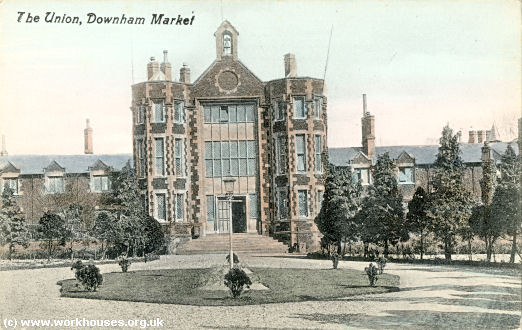
Downham Market workhouse from the west, c.1905
© Peter Higginbotham.
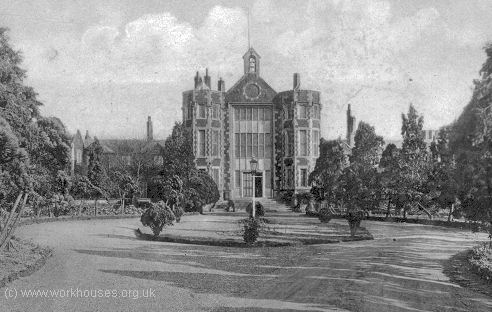
Downham Market workhouse from the west, c.1905
© Peter Higginbotham.
The workhouse was designed by William J Donthorn who was the architect of other Norfolk workhouses at Aylsham, Erpingham, Freebridge Lynn, Swaffham, and Ely. Like Ely, Donthorn's design for Downham was loosely based on the popular cruciform layout but with shortened wings at the front of the building to the west. The workhouse location and layout are shown on the 1885 map below.
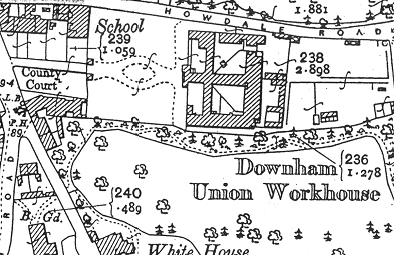
Downham workhouse site, 1885
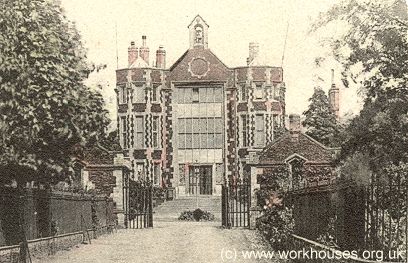
Downham Market workhouse from the west, c.1910
© Peter Higginbotham.
In 1894, the British Medical Journal set up a "commission" to investigate conditions in provincial workhouses and their infirmaries. Following a visit to the Downham establishment, the commission's report sympathised with the Board of Guardians over the "unmanageable structure" which served as the infirmary but suggested that the sick might be housed in some other part of the workhouse, which was genereally little more than a quarter full. Amongst there other suggestions was that the sole and untrained nurse would benefit considerably from even a modest amount of formal training. Further details are available in the full report.
In 1898, the St Edmund's Downham Market parish magazine published an article marking the retirement of the long-serving master and matron of the workhouse:
After 1904, for birth registration purposes, the workhouse was identified as the Howdale Home, Downham Market.
The Downham workhouse buildings no longer exist and the site is now occupied by a care home for the elderly.
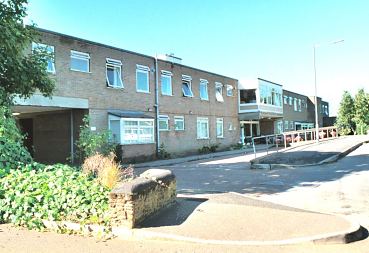
Downham Market former workhouse site from the north-east, 2001.
© Peter Higginbotham.
Staff
Inmates
Records
Note: many repositories impose a closure period of up to 100 years for records identifying individuals. Before travelling a long distance, always check that the records you want to consult will be available.
- Norfolk Record Office, The Archive Centre, Martineau Lane, Norwich NR1 2DQ. Holdings include: Guardians' minute books (1836-1930); Admissions and discharges (1905-8, 1911-16); Vaccination registers (1899-21); etc.
Bibliography
- Pauper Palaces by Ann Digby (Routledge & Kegan Paul, 1978)
Links
Unless otherwise indicated, this page () is copyright Peter Higginbotham. Contents may not be reproduced without permission.


